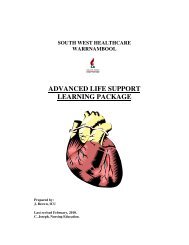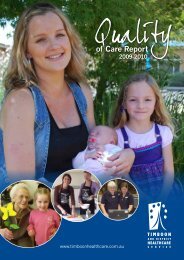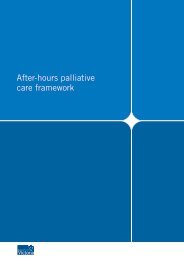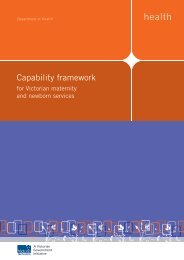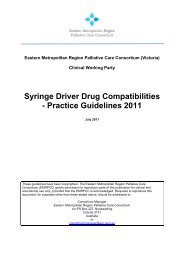Self Directed Learning Package - University of Queensland
Self Directed Learning Package - University of Queensland
Self Directed Learning Package - University of Queensland
- No tags were found...
You also want an ePaper? Increase the reach of your titles
YUMPU automatically turns print PDFs into web optimized ePapers that Google loves.
85 • <strong>Self</strong> <strong>Directed</strong> <strong>Learning</strong> <strong>Package</strong> - Advanced Registered & Enrolled NurseInitial assessmentModified Resident’s Verbal Brief Pain Inventory (M-RVBPI)A copy <strong>of</strong> this tool can be found in Module 3.• Although this tool is primarily utilised with competentresidents, it is also reliable and valid for residents who havemild dementia. You can enlist a careworker or relative to jointlyreport when there is moderate to severe dementia.• The M-RVBPI assesses physical and psychosocial factorsrelevant to pain in appropriate detail. Pain intensity and theeffectiveness <strong>of</strong> current treatments is also evaluated.• On average, it takes about seven minutes to administer.• The first question determines the need for further assessment.If the answer to the first question is ‘no’, no further questionsare indicated.• A body map records and defines the site <strong>of</strong> pain.This is helpful in evaluating the cause <strong>of</strong> pain.• The size <strong>of</strong> the area in which pain is felt, the shape(distribution) and travel path (radiation) also suggest theunderlying cause (for example, sciatica).• Identifying the location <strong>of</strong> the pain also guides the effectiveapplication <strong>of</strong> local treatments.• The remainder <strong>of</strong> the M-RVBPI looks at the impact <strong>of</strong> pain onactivity, mood, mobility, socialisation and sleep. 2Case Study: JudyJudy, who we met earlier, has advanced bowel cancer witha fungating rectal mass as well as metastasis in her liver andbones (right hip and ribs).You sit with her just after she’s been assisted with hershower. She looks like she wants to cry when you ask her ifshe has any pain.She describes:1. Severe pain in her ‘bottom’ when she is sitting on a chair.This stops her from going to the activities room to playbridge with her friends.2. Moderate hip pain when she walks or moves in bed (dropsto mild when lying still but never goes away completely).3. Mild discomfort in the right upper quadrant <strong>of</strong> herabdomen radiating to her right shoulder.Judy tells you that she always has some level <strong>of</strong> pain,especially in her hip.Thinking PointRefer back to the assessment you made <strong>of</strong> Judy’spain. How would you classify each pain she describes?Key PointCompleting an assessment is important BUT equallyimportant is doing something with the informationthat is obtained. Be sure to follow the action guideat the bottom <strong>of</strong> the M-RVBPI form.ActivityRead through the M-RVBPI and scoring instructions.Then complete the tool using the informationprovided about Judy.Ongoing assessmentPain rating scales are the best tools for ongoing pain assessmentand intervention evaluations.



